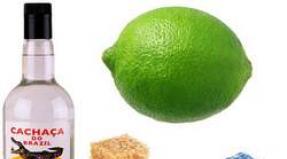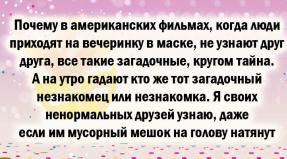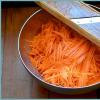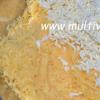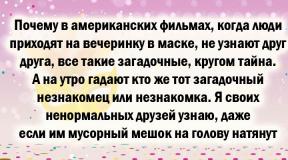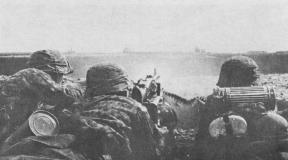Rules for drawing up a formula for valence. Lesson summary: Drawing up formulas for compounds by valence. Lesson type: combined
Atomic-molecular science. Atoms. Molecules. Molecular and non-molecular structure of matter. Relative atomic and molecular mass. The law of conservation of mass, its significance in chemistry. A mole is a unit of quantity of a substance. Molar mass. Avogadro's law and the molar volume of gas. Relative density of a substance.
Chemistry subject. Chemical and physical phenomena.
Chemistry is the science of substances and their transformations. She studies the composition and structure of substances, the dependence of their properties on their structure, the conditions and methods of converting some substances into others.
Chemistry is of great practical importance. Many thousands of years ago, man used chemical phenomena to smelt metals from ores, obtain alloys, melt glass, etc. Back in 1751. M.V. Lomonosov in his famous “Tale on the Benefits of Chemistry” wrote: “Chemistry spreads its hands widely into human affairs. Wherever we look, wherever we look, the successes of its application appear before our eyes.”
Nowadays, the role of chemistry in the life of society is immeasurable. Chemical knowledge has now reached such a level of development that, on its basis, ideas about the nature and mechanism of a number of the most important natural and technological processes are radically changing. Chemistry has helped us discover and use not only previously unknown properties of substances and materials, but also to create new substances and materials that do not exist in nature.
Substance is a type of matter that, under certain conditions, has constant physical properties. However, as conditions change, the properties of the substance change.
Any changes that occur with matter are called phenomena. Phenomena are both physical and chemical.
Physical phenomena are those that lead to a change in the shape, state of aggregation, and temperature of a substance without changing its composition. The chemical composition of a substance does not change as a result of a physical phenomenon. For example, water can be turned into ice, into steam, but its chemical composition remains the same.
Chemical phenomena are those in which a radical change in the composition and properties of substances occurs. As a result of chemical phenomena, the transformation of some substances into others occurs, i.e. the composition of molecules changes, molecules of another substance are formed. However, atoms remain unchanged during chemical reactions. An example is the decomposition of limestone:
CaCO3 → CaO + CO2
Chemical phenomena are otherwise called chemical reactions. Characteristic signs of chemical phenomena (reactions): release of heat, gas, precipitation, color change, odor. This cannot be observed in physical phenomena.
The theoretical basis of modern chemistry is atomic-molecular science.
Atoms are the smallest chemical particles that are the limit of chemical decomposition of any substance.
A chemical element is a type of atom with the same positive nuclear charge.
Hence, an atom is the smallest particle of a chemical element that retains all its chemical properties. Currently, 110 elements are known, of which 92 occur in nature.
Depending on the nature of the particles from which the substance is built, substances with molecular and non-molecular structures are distinguished. Almost all organic substances (i.e., the vast majority of known substances) are composed of molecules. Among inorganic compounds, approximately 5% have a molecular structure. Thus, the most typical form of existence of a substance is a molecule.
A molecule is the smallest particle of a substance that can exist independently and retain its basic chemical properties.
Under normal conditions, substances with a molecular structure can exist in a solid, liquid or gaseous state. Substances with a non-molecular structure are found only in the solid state, mainly in crystalline form. The carriers of the chemical properties of such substances are not molecules, but combinations of atoms or ions that form a given substance.
The symbolic notation of the simplest numerical relationship in which atoms of different elements form a chemical compound is called formula. Consequently, the formula expresses the specific (qualitative and quantitative) composition of the compound. So, SO2, N2, CO are the formulas of substances with a molecular structure. Their composition is always strictly constant. NaCl, AlF3, ZnS are the formulas of substances that do not have a molecular structure under normal conditions. The composition of such substances is not always constant and often depends on the conditions of their production. Deviations from the integer ratio can be expressed by writing the formula: Fe0.9S, TiO0.7, ZrN0.69. Substances with a constant composition are called colorblind, substances with variable composition - berthollides.
The masses of atoms of chemical elements are extremely small. In chemistry, they do not use their absolute values, but their relative ones.
The relative atomic mass of a chemical Ar element is a value equal to the ratio of the average mass of atoms of a given element (taking into account the percentage of its isotopes in nature) to 1/12 of the mass of carbon isotopes - 12. 1\12 of the mass of an atom of carbon isotope 12 is taken as atomic mass unit(a.u.m.), international designation - u.
Relative atomic mass is a dimensionless quantity.
The relative molecular mass Mr of a substance is the ratio of the mass of its molecule to 1/12 of the mass of an atom of the carbon isotope 12.
Since most inorganic substances under normal conditions do not have a molecular structure, in this case we can talk about formula mass F, meaning by it the sum of the atomic masses of all elements included in the compound, taking into account the number of atoms of each element in the formula.
The unit for measuring the amount of substance n (ν) in the International System of Units is mole.
Mole is the amount of substance containing as many structural elementary units (atoms, ions, molecules, electrons, equivalents, etc.) as there are atoms in 0.012 kg of the carbon 12 isotope.
The number of NA atoms in 0.012 kg of carbon (i.e. in 1 mol) is easy to determine, knowing the mass of the carbon atom. The exact value of this value is 6.02·10²³. This quantity is called Avogadro's constant and is one of the most important universal constants. It is equal to the number of structural units in 1 mole of any substance.
The mass of 1 mole of substance X is called molar mass M(X) is the ratio of the mass m of this substance to its quantity n.
Law of Conservation of Mass: “The mass of substances that entered into a chemical reaction is equal to the mass of substances formed as a result of the reaction, taking into account the mass corresponding to the thermal effect of the reaction.” It was formulated by the great Russian scientist M.V. Lomonosov in 1748. and confirmed experimentally by himself in 1756. and independently of him by the French chemist A.L. Lavoisier in 1789.
Law of constancy of the composition of matter: “Any complex substance of molecular structure, regardless of the method of production, has a constant quantitative composition.”
Avogadro's Law: “Equal volumes of different gases under the same conditions contain the same number of molecules.”
Consequences: 1. If the number of molecules of some gases is equal, then at no. they occupy equal volumes. If the number of molecules is 6.02·10²³, then the volume of the gas is 22.4 liters. This volume is called molar volume.
1. The absolute density of a gas is equal to the ratio of its molecular mass to its molar volume
2. The relative density of a gas (X) to another gas (Y) is equal to the ratio of the molar mass of the gas (X) to the molar mass of the gas (Y).
Claperon equation:
Boyle-Marriott equation:
Charles-Gay-Lusac equation:
| |
Chemical element. Simple and complex substances. Chemical formulas.
A type of atom with the same chemical properties is called an element. Atoms of the same element can differ only in mass. Their chemical properties are the same. There are varieties of atoms of the same element called isotopes.
The concept of “chemical element” equally refers to atoms of a given element, both in free form and those included in compounds.
Molecules are formed from atoms. Depending on whether the molecule consists of atoms of the same element or of atoms of different elements, all substances are divided into simple and complex.
Simple substances are those whose molecules consist of atoms of one element. Molecules of simple substances can consist of one, two or more atoms of one element. At present, it is indisputable that the same element exists in a free state in the form of a number of different forms, i.e. in the form of several simple substances.
The existence of an element in the form of several simple substances is called allotropy. Simple substances formed by the same element are called allotropic modifications this element. These modifications differ both in the number and arrangement of the same atoms in the molecule.
Complex substances or chemical compounds are those whose molecules consist of atoms of two or more elements. Atoms that enter into a chemical compound do not remain unchanged. They influence each other mutually. In different molecules, atoms are in different states.
A chemical formula is a representation of the composition of a substance using chemical symbols. Chemical formulas indicate the molecule of a substance, its qualitative and quantitative composition.
An important concept in chemistry is valence . Valency is the ability of an atom to connect with other atoms through a certain number of chemical bonds. The numerical value of valency is determined by the total number of atomic orbitals involved in the formation of a chemical bond:
| ↓ | |||
| ↓ | ↓ |
CO: C≡O C: 1s 2 2s 2 2p 2 valence: 3
O: 1s 2 2s 2 2p 4
All of the above applies to compounds with covalent bonds. If an element forms ionic bonds, its valence is called stoichiometric. It says nothing about the number of connections. The highest valence is equal to the number of the group in which the element is located, however, N, O and F have the highest valency - 4. This is explained by the fact that the atoms of these elements cannot go into an excited state due to the lack of vacant orbitals in the wind turbine.
Lesson topic: Drawing up chemical formulas of binary compounds by valency.
“The scientific study of objects has two main or ultimate goals: prediction and benefit.”
D. I. Mendeleev
Goals:
Educational: consider the concept of “valence” as the atomicity of an element, teach students to determine valency in binary compounds, introduce students to different types of valence, repeat the concepts of a multiple of a given number, the least common multiple of several numbers, repeat the rule for finding the LCM of several numbers and the application of this rule; draw students' attention to the integration of chemistry and mathematics courses.
Educational: develop the cognitive interest of students, develop the ability to reason logically, apply previously acquired knowledge, and correctly express their thoughts.
Educational: promote interest in the subject, in the result of one’s work, develop the ability to work in pairs, collectively, and evaluate the answers of one’s comrades.
Planned learning outcomes:
Students should know:
definition of the concept of “valence”;
valency of hydrogen and oxygen atoms in compounds.
Students should be able to:
determine the valence of atoms of other elements in binary compounds by the valence of hydrogen and oxygen atoms;
determine the valence of atoms of elements according to the formulas of substances, using an algorithm for solving problems.
Basic concepts: valence, constant and variable valence, binary compounds, least common multiple.
Lesson type: combined.
Means of education: algorithm for determining valence.
Equipment: Periodic table of chemical elements by D.I. Mendeleev, ball-and-stick models of molecules, table “Algorithm for determining valence.”
During the classes
Organizational stage: welcoming students.
Updating basic knowledge.
Frontal conversation chemistry teachers with students on the topic “Chemical formula”.
When studying chemistry, it is very important to learn how to formulate chemical formulas.
What does a chemical formula express? (composition of a certain substance taken in its pure form)
Chemical formula- this is a symbol for a substance, atom, molecule, ion using symbols of elements, numerical and auxiliary signs.
From the chemical formula we can determine:
Type of substance
Qualitative and quantitative composition,
Relative molecular weight,
Mass fraction of a chemical element in a given substance,
Valency of chemical elements.
All substances are made up of atoms. One of the main properties of atoms is the ability to form chemical bonds. Atoms of different elements can form a certain number of bonds characteristic of them.
Let's compare the qualitative and quantitative composition in molecules: HCl, H 2 O, NH 3, CH 4.
What do molecules have in common? (presence of hydrogen atoms)
How do these substances differ from each other? (these substances have different numbers of hydrogen atoms)
A hydrogen atom cannot attach more than one atom of another chemical element, therefore the valency of hydrogen is taken as one. And therefore, the valence of all other elements is compared with the valency of hydrogen.
Examples:
HCl - one chlorine atom bonded to one hydrogen atom;
H 2 O - one oxygen atom binds two hydrogen atoms;
NH 3 - one nitrogen atom binds three hydrogen atoms;
CH 4 - one carbon atom binds four hydrogen atoms.
Why do different atoms hold different numbers of hydrogen atoms?
( Each atom forms a certain number of bonds with other atoms).
It's called valence.
Valence- this is the property of atoms to hold a certain number of other atoms in a compound.
Valence is indicated by Roman numerals.
Notes on the board and in notebooks:
| I I | I II | I III | I IV |
The valence of the hydrogen atom is taken as one - I, and that of oxygen - II.
Student report of valence.
At the beginning of the 19th century, J. Dalton formulated the law of multiple relations, from which it followed that each atom of one element can combine with one, two, three, etc. atoms of another element (as, for example, in the compounds of atoms with hydrogen that we considered).
In the middle of the 19th century, when the exact relative weights of atoms were determined (I.Ya. Berzelius and others), it became clear that the largest number of atoms with which a given atom can combine does not exceed a certain value, depending on its nature. This ability to bind or replace a certain number of other atoms was called “valence” by E. Frankland in 1853.
Since at that time there were no compounds known for hydrogen in which it was bonded to more than one atom of any other element, the hydrogen atom was chosen as the standard, having a valence of 1.
At the end of the 50s. In the 19th century, A. S. Cooper and A. Kekule postulated the principle of constant tetravalency of carbon in organic compounds. The concept of valency formed an important part of the theory of chemical structure of A. M. Butlerov in 1861.
Periodic law D.I. Mendeleev in 1869 revealed the dependence of the valency of an element on its position in the periodic table.
Contributions to the evolution of the concept of “valence” over the years were made by V. Kossel, A. Werner, and G. Lewis.
Since the 30s. In the 20th century, ideas about the nature and character of valence constantly expanded and deepened. Significant progress was made in 1927, when W. Heitler and F. London performed the first quantitative quantum chemical calculation of the hydrogen molecule H 2 .
Conversation with students:What is valence?
The definition of valence sounds different in different sources. Let's think about which of these three definitions is more perfect and what are the shortcomings of the others.
1st row
"Valence
of a chemical element is the ability of its atoms to combine with other atoms in certain proportions.”
2nd row
"Valence
- the ability of atoms of one element to attach a certain number of atoms of another element.”
3rd row
"Valence
- the property of atoms, when entering into chemical compounds, to give or accept a certain number of electrons or to combine electrons to form electron pairs common to two atoms.”
Discussion in groups, We come to the conclusion that the 3rd definition most accurately reflects the essence of the definition of valency.
Presentation of new material:
Topic of our lesson: Drawing up formulas for binary compounds by valency.
New material is remembered more easily if it is combined with knowledge already acquired. Therefore, now we have to work with retrieving this material from memory. And your math teacher will help you with this.
The teacher conducts a dialogue with the students:
Teacher: list several numbers that are multiples of 12.
12, 24, 36, 48 ….
Teacher: list several numbers that are multiples of 18.
18, 36, 54, 72……
Teacher: name the numbers that are multiples of both 12 and 18.
36 and 72, etc.
Teacher: name the least common multiple of 12 and 18.
Teacher: State the definition of the least common multiple of several numbers.
The least common multiple of several numbers is the smallest natural number that is divisible by each of the given numbers.
Teacher: formulate a rule for finding the least common multiple of two or more numbers.
To find the LCM of two or more numbers, you need to decompose these numbers into prime factors, then, taking the decomposition of one of them, multiply it by the missing prime factors from the decompositions of other numbers.
The teacher suggests the following exercise:
№1 . Find A) LOC (48, 90); B) NOC (6, 15, 20)
Solution:
A) 48/2 90/2 B) 6/2 15/3 20/2
24/2 45/3 3/3 5/5 10/2
12/2 15/3 1/ 1/ 5\5
LCM (48,90) = 2 4 *3*3*5 LCM (6,15,20) = 2 3 * 5 * 3
LOC (48,90) = 720 LOC (6,15,20) = 60
Answer: A) 720; B) 60.
Teacher: What is the LCM of two relatively prime numbers?
The LCM of two coprime numbers is equal to their product.
№2. Find LOC (7,11)
Teacher: As you remember, there is another way to find the LCM of numbers - this is the selection method.
Find the NOC the following numbers using the selection method:
A) 10 and 2 B) 14 and 21 C) 20 and 15 D) 2; 3 and 5
Answers: A) 10 B) 42 C) 60 D) 30.
Teacher: Guys, we have repeated how you can find the LCM of two or more numbers. And now you will get acquainted with how this knowledge is used in chemistry when determining valency.
V. Goethe once said: “Just knowing everything is not enough; you need to be able to use knowledge.”
Determination of the valency of elements using formulas in binary compounds.
Remember: in the formulas of binary compounds, the number of valence units of all atoms of one element is equal to the number of valency units of all atoms of another element.
Write down the formula of the substance. R 2 O 5
Use a Roman numeral to indicate the valency of one of the elements. P 2 O 5 (II)
Determine the valence of another chemical element. R 2 O 5
X*2= II *5 X = V
Drawing up chemical formulas of binary compounds according to the valence of elements.
Writing down symbols chemical elements included in the formula, indicating the corresponding valence values above them:
CaO, B 2 O 3, CO 2,
Making up the formula compounds by valency:
a) CaO: if the valencies of chemical elements are equal, then we do not put indices.
b) B 2 O 3: if the valence values are not divisible by each other, we put the valence values crosswise.
c) CO 2: if the valence of one element is divided by the valency of another, then divide the value of the higher valency by the value of the lower and place the resulting number as an index next to the element with the lower valency.
Exercise: Determine the valency of elements in substances: students come to the board in a chain. We project the task onto the board.
SiH 4, CrO 3, H 2 S, CO 2, CO, SO 3, SO 2, Fe 2 O 3, FeO, HCl, HBr, Cl 2 O 5, Cl 2 O 7, PH 3, K 2 O, Al 2 O 3, P 2 O 5, NO 2, N 2 O 5, Cr 2 O 3, SiO 2, B 2 O 3, SiH 4, Mn 2 O 7, MnO, CuO, N 2 O 3.
Evaluative-reflective stage.
Primary test of knowledge acquisition. To complete this task, students receive an “Algorithm for determining valence” and tasks of three levels. Each student chooses his own task level.
Reproductive level (“3”). Determine the valence of atoms of chemical elements using the formulas of compounds: NH 3, Au 2 O 3, SiH 4, CuO.
Application layer (“4”). From the given series, write down only those formulas in which the metal atoms are divalent: MnO, Fe 2 O 3, CrO 3, CuO, K 2 O, CaH 2.
Creative level (“5”). Find a pattern in the sequence of formulas: N 2 O, NO, N 2 O 3 and put the valencies above each element.
| Valency determination algorithm | Example |
|
| 1. Write down the formula of the substance. | ||
| 2. Designate the known valence of the element | ||
| 3. Find the number of valence units of atoms of a known element by multiplying the valency of the element by the number of its atoms | ||
| 4. Divide the number of valency units of the atoms by the number of atoms of the other element. The resulting answer is the desired valence | 2 | 2 |
| 5. Do a check, that is, count the number of valence units of each element | I II | I II |
We mutually check the completed task(students exchange notebooks).
Troubleshooting: o answers on the board.
Summing up the lesson.
Conversation with students:
What problem did we pose at the beginning of the lesson?
What conclusion have we reached?
Define “valence”.
How to determine NOC?
What is the valency of a hydrogen atom? Oxygen?
How to determine the valency of an atom in a compound?
Evaluation of student work.
Homework: textbook G. E. Rudzitis, F. G. Feldman §17, p. 60, ex. 1, 2, 4, 6
Problematic question: Why do hydrogen and lithium have a constant valence, but helium has no valency?
“How students can succeed – catch up with those who are ahead and not wait for those who are behind”
Aristotle
We wish you to always be ahead.
Lesson type. Combined.
Teaching methods. Partially searchable.
Goals. Didactic: consolidate the concept of “valency”, skills in determining valency using the formula and the Periodic Table.
Psychological: arouse interest in the subject, develop the ability to reason logically, and correctly express one’s thoughts.
Educational: develop the ability to work collectively, evaluate the answers of your comrades.
Equipment. Kits for building models of molecules of various substances, anagram tablets for chemical warm-up, efficiency target
DURING THE CLASSES
1. Indicative-motivational stage
Chemical warm-up
Anagrams are words in which the order of the letters has been changed. Try to solve some of the chemical anagrams. Rearrange the letters in each word and get the name of the chemical element. Pay attention to the hint.
“Odovrod” – this element has the smallest relative atomic mass.
“Mailinu” – this element is called “winged” metal.
“Dikosolr” is part of the air.
“Tsalkiy” - without it our bones would be weak and fragile.
“Ozegel” - this element is part of the blood and is involved in the transfer of oxygen.
Teacher. If you can easily guess the anagram words, tell yourself: “I’m great!”
2. Updating knowledge
Catch a mistake (Guys look for a mistake, work in pairs, argue, confer. Having come to an opinion, they offer their own reasoned answer)
The word “valency” (from the Latin “valentia”) arose in the middle of the 19th century, during the period of completion of the chemical-analytical stage of the development of chemistry. “Valency is the ability of atoms of one element to attach a certain number of atoms of another element.” One atom of another monovalent element (HF, NaCl) is combined with one atom of a monovalent element. Combine with an atom of a divalent element one atom of monovalent (H 2 O) or one divalent atom (CaO). This means that the valence of an element can be represented as a number that shows how many atoms of a monovalent element an atom of a given element can combine with.
There are elements that have constant valence:
monovalent (I) - H, Li, Na, Rb, Cs, F, I
divalent (II) - Be, Mg, Ca, Sr, Ba, Zn, Cd K
trivalent (III) - B, Al, O
Tic Tac Toe: (Connect the elements with a straight line, the criterion for the correct answer is the constant valence of the selected elements)
1 option
Option 2
3. Learning new knowledge
Task 1: the general formula for combining hydrogen with any element is given
Knowing that the valency of hydrogen is I, determine the valence of the element.
The guys work in pairs, if necessary, they unite in groups of four, argue, and confer. Having come to an opinion, they offer their own reasoned answer. As a result, we get scheme No. 1
scheme 1
Task for consolidation:
- determine the valences of elements in compounds with hydrogen: PH 3, HF, H 2 S, CaH 2,
- name the connections.
Task 2: in the same way, you can determine the valence of elements in compounds with oxygen, knowing that oxygen is divalent. For example:
The guys work in pairs, if necessary, they unite in groups of four, argue, and confer. Having come to an opinion, they offer their own reasoned answer. As a result, we get scheme No. 2
 scheme 2
scheme 2
Task for consolidation:
- Determine the valences of elements in compounds with oxygen:
- What are binary compounds containing oxygen called?
NO 2, N 2 O 5, SO 2, SO 3, Cl 2 O 7.
Task 3: what do you need to know in order to determine the valence of elements in a binary compound? (valence of one of the elements)
Determine the valence of atoms in a compound
The guys work in pairs, if necessary, they unite in groups of four, argue, and confer. Having come to an opinion, they offer their own reasoned answer. As a result, we get scheme No. 3

Teacher: which of the following diagrams
 scheme 2
scheme 2

most fully reflects the rule for determining valency using the formula? (Scheme 3, because it reflects the general case, and Schemes 1 and 2 are only particular)
4. Consolidation of the studied material.
Independent work
The text of the work is written in advance on the board. Two students solve the problem on the back of the board, the rest in their notebooks.
Task 4. Check whether the formulas of the following compounds are written correctly: Na 2 S, KBr, Al 2 O 3, Mg 3 N 2, MgO.
5. Generalization and systematization of knowledge.
Creative work in groups
Task 5. Using kits for making models of molecules of various substances, create formulas and models of molecules for the following compounds:
1st group – copper and oxygen,
2nd group – zinc and chlorine,
3rd group – potassium and iodine,
4th group – magnesium and sulfur.
After finishing the work, one student from the group reports on the completed task and, together with the class, analyzes the errors.
Task 6. Write the formulas for compounds of metals with non-metals: calcium with oxygen, aluminum with chlorine, sodium with phosphorus. Name these connections.
After completing the work, students exchange notebooks and mutual checking takes place.
Task 7. Write down the procedure for drawing up formulas of substances, analyzing the proposed example
Procedure |
|
6. Reflection
You have the opportunity to self-assess your activities in class. You are presented with an “Efficiency Target”.
Mark your knowledge on a new topic by marking the corresponding sector in the picture with shading. Submit your notes.

7. Homework. According to the textbook “Chemistry-8” (UMK Kuznetsova N.E. and others) § 14, exercise 1-71 is mandatory (additional from 1-72 to 1-74).
Reports about the French scientist J.L. Proust and the English scientist J. Dalton.
Literature
- Kuznetsova N.E. and others. Chemistry: Textbook for 8th grade students of general education institutions. - M.: Ventana-Graf, 2010. - 320 pp.: ill.
- Kuznetsova N.E., Shatalov M.A. Teaching chemistry based on interdisciplinary integration: grades 8-9: Educational manual. - M.: Ventana-Graf, 2004. - 352 p.
- Emelyanova E.O., Iodko A.G. Organization of cognitive activity of students in chemistry lessons in grades 8-9. Basic notes with practical tasks, tests: In 2 parts. Part I. – M.: School press, 2002.- 144 p.
- Kuznetsova L.M. New technology for teaching chemistry in grade 8. - Obninsk: Title, 1999. - 208 p.: ill.
The lesson discusses an algorithm for compiling chemical formulas of substances based on the known valences of chemical elements. The teacher will explain two different ways to derive the chemical formula of a substance.
2. determine the number of common valence units, it is equal to the smallest common multiple of the valences of the elements: LCM (2,4) = 4;
3. determine the number of atoms of each chemical element in the molecule by dividing the number of common valence units by the valence of the element;
4. write down the formula of the substance: SO 2.
Example 2. Let's make a formula for a substance formed by phosphorus atoms (with valence V) and oxygen atoms.
1. Let's write down the signs of the elements and indicate their valencies above them: .
2. Find the number of common valency units: LCM(2.5)=10
3. Find the number of phosphorus atoms in the molecule: 10:5=2.
4. Find the number of oxygen atoms in the molecule: 10:2=5.
5. Let's write down the formula of the substance: .

Rice. 2. Drawing up the chemical formula of phosphorus oxide
1. Emelyanova E.O., Iodko A.G. Organization of cognitive activity of students in chemistry lessons in grades 8-9. Basic notes with practical tasks, tests: Part I. - M.: School Press, 2002. (p. 33)
2. Ushakova O.V. Chemistry workbook: 8th grade: to the textbook by P.A. Orzhekovsky and others. “Chemistry. 8th grade” / O.V. Ushakova, P.I. Bespalov, P.A. Orzhekovsky; under. ed. prof. P.A. Orzhekovsky - M.: AST: Astrel: Profizdat, 2006. (p. 36-38)
3. Chemistry: 8th grade: textbook. for general education institutions / P.A. Orzhekovsky, L.M. Meshcheryakova, L.S. Pontak. M.: AST: Astrel, 2005.(§16)
4. Chemistry: inorg. chemistry: textbook. for 8th grade. general education institutions / G.E. Rudzitis, F.G. Feldman. - M.: Education, OJSC “Moscow Textbooks”, 2009. (§§11,12)
5. Encyclopedia for children. Volume 17. Chemistry / Chapter. ed.V.A. Volodin, Ved. scientific ed. I. Leenson. - M.: Avanta+, 2003.
Additional web resources
1. Unified collection of digital educational resources ().
2. Electronic version of the journal “Chemistry and Life” ().
Homework
1. p.84 No. 3,4 from the textbook “Chemistry: 8th grade” (P.A. Orzhekovsky, L.M. Meshcheryakova, L.S. Pontak. M.: AST: Astrel, 2005).
2. With. 38 No. 9 from the Workbook in Chemistry: 8th grade: to the textbook by P.A. Orzhekovsky and others. “Chemistry. 8th grade” / O.V. Ushakova, P.I. Bespalov, P.A. Orzhekovsky; under. ed. prof. P.A. Orzhekovsky - M.: AST: Astrel: Profizdat, 2006.
Topic No. 11 “Drawing up chemical formulas by valency.”
- Nomenclature of binary compounds.
Complex substances consisting of two elements, one of which is:
Bromides
NaBr
Chlorides
AlCl₃
Oxides
Sulfides
Nitrides
Ca₃N₂
Yodides
Hydrides
Name the substances: CrCl₃, MnO₂, H₂O, Li₂S, SO₃, Ca₃N₂, BaO, FeCl₃.
- Fill in the missing words in the phrases:
- water contains two......hydrogen and oxygen.
- The human body contains a large amount of………. elements.
- ...sulfuric acid H₂ SO ₄ consist of two….hydrogen, one…. sulfur and four.....oxygen.
- …. aluminum chloride consists of….two……..
- ......water is part of all living organisms.
- …. nitrogen forms complex organic substances proteins.
- Chemical……. aluminum is the second most abundant element in the earth's crust.
- Make up the formulas:
Carbon(II) monoxide - cobalt(II) chloride
Carbon (IV) monoxide - iron (III) nitride
Phosphorus(III) chloride - copper(II) sulfide
Aluminum bromide - manganese (VII) oxide
Magnesium iodide - chromium (III) oxide
Potassium hydride - calcium hydride
W. Determine the valencies of chemical elements in NH formulas₃ and CaO and create a formula for the compound of calcium and nitrogen in which they exhibit the same valency. Name all three substances found in the task.
D/z. 1. Determine the valence of elements in compounds: KClO₃, AlPO₄, CaCO₃, FeSO₄
